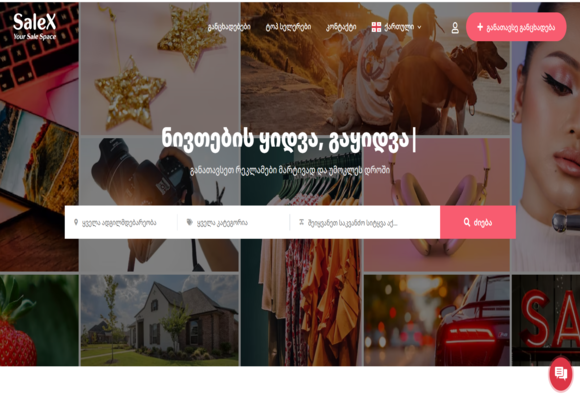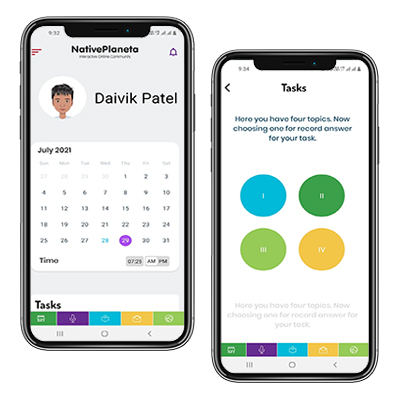
- Dharti D.
- 30,Jan 2021
- Technology
What is Virtual Reality?
Virtual reality is an artificial environment that is created with software and presented to the user in such a way that the user suspends belief and accepts it as a real environment. On a computer, virtual reality is primarily experienced through two of the five senses: sight and sound. The simplest form of virtual reality is a 3-D image that can be explored interactively at a personal computer, usually by manipulating keys or the mouse so that the content of the image moves in some direction or zooms in or out. More sophisticated efforts involve such approaches as wrap-around display screens, actual rooms augmented with wearable computers, and haptics devices that let you feel the display images. In Technical Terms... Answering “what is virtual reality” in technical terms is straight-forward. Virtual reality is the term used to describe a three-dimensional, computer generated environment which can be explored and interacted with by a person. That person becomes part of this virtual world or is immersed within this environment and whilst there, is able to manipulate objects or perform a series of actions.How is virtual reality achieved?
Although we talk about a few historical early forms of virtual reality elsewhere on the site, today virtual reality is usually implemented using computer technology. There are a range of systems that are used for this purpose, such as headsets, omni-directional treadmills and special gloves. These are used to actually stimulate our senses together in order to create the illusion of reality. This is more difficult than it sounds, since our senses and brains are evolved to provide us with a finely synchronised and mediated experience. If anything is even a little off we can usually tell. This is where you’ll hear terms such as immersiveness and realism enter the conversation. These issues that divide convincing or enjoyable virtual reality experiences from jarring or unpleasant ones are partly technical and partly conceptual. Virtual reality technology needs to take our physiology into account. For example, the human visual field does not look like a video frame. We have (more or less) 180 degrees of vision and although you are not always consciously aware of your peripheral vision, if it were gone you’d notice. Similarly when what your eyes and the vestibular system in your ears tell you are in conflict it can cause motion sickness. Which is what happens to some people on boats or when they read while in a car. If an implementation of virtual reality manages to get the combination of hardware, software and sensory synchronicity just right it achieves something known as a sense of presence. Where the subject really feels like they are present in that environment.Virtual Reality Technology
Virtual Reality’s most immediately-recognizable component is the head-mounted display (HMD). Human beings are visual creatures, and display technology is often the single biggest difference between immersive Virtual Reality systems and traditional user interfaces. For instance, CAVE automatic virtual environments actively display virtual content onto room-sized screens. While they are fun for people in universities and big labs, consumer and industrial wearables are the wild west. With a multiplicity of emerging hardware and software options, the future of wearables is unfolding but yet unknown. Concepts such as the HTC Vive Pro Eye, Oculus Quest and Playstation VR are leading the way, but there are also players like Google, Apple, Samsung, Lenovo and others who may surprise the industry with new levels of immersion and usability. Whomever comes out ahead, the simplicity of buying a helmet-sized device that can work in a living-room, office, or factory floor has made HMDs center stage when it comes to Virtual Reality technologies.Virtual Reality and the importance of audio
Convincing Virtual Reality applications require more than just graphics. Both hearing and vision are central to a person’s sense of space. In fact, human beings react more quickly to audio cues than to visual cues. In order to create truly immersive Virtual Reality experiences, accurate environmental sounds and spatial characteristics are a must. These lend a powerful sense of presence to a virtual world. To experience the binaural audio details that go into a Virtual Reality experience, put on some headphones and tinker with this audio infographic published by The Verge.Virtual reality can be divided into:
- The simulation of a real environment for training and education.
- The development of an imagined environment for a game or interactive story.
Why have virtual reality?
This may seems like a lot of effort, and it is! What makes the development of virtual reality worthwhile? The potential entertainment value is clear. Immersive films and video games are good examples. The entertainment industry is after all a multi-billion dollar one and consumers are always keen on novelty. Virtual reality has many other, more serious, applications as well. There are a wide variety of applications for virtual reality which include:- Architecture
- Sports
- Medicine
- The Arts
- Entertainment
Features of virtual reality systems
There are many different types of virtual reality systems but they all share the same characteristics such as the ability to allow the person to view three-dimensional images. These images appear life-sized to the person. Plus they change as the person moves around their environment which corresponds with the change in their field of vision. The aim is for a seamless join between the person’s head and eye movements and the appropriate response, e.g. change in perception. This ensures that the virtual environment is both realistic and enjoyable. A virtual environment should provide the appropriate responses – in real time- as the person explores their surroundings. The problems arise when there is a delay between the person’s actions and system response or latency which then disrupts their experience. The person becomes aware that they are in an artificial environment and adjusts their behaviour accordingly which results in a stilted, mechanical form of interaction. The aim is for a natural, free-flowing form of interaction which will result in a memorable experience.Forms and Methods
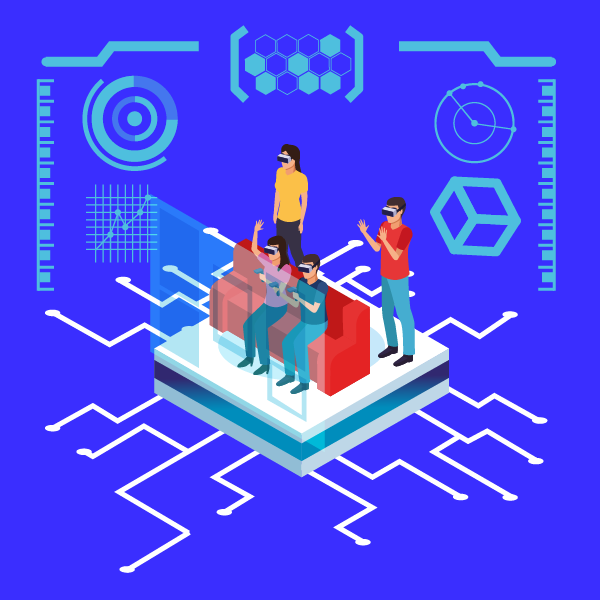
Simulation based virtual reality
One method by which virtual reality can be realized is simulation-based virtual reality. Driving simulators, for example, give the driver on board the impression of actually driving an actual vehicle by predicting vehicular motion caused by driver input and feeding back corresponding visual, motion and audio cues to the driver.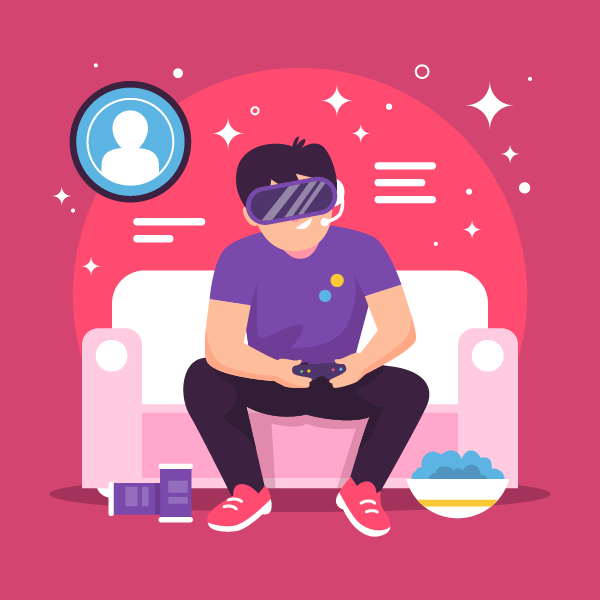
Avatar image based virtual reality
With avatar image-based virtual reality, people can join the virtual environment in the form of real video as well as an avatar. One can participate in the 3D distributed virtual environment as form of either a conventional avatar or a real video. A user can select own type of participation based on the system capability.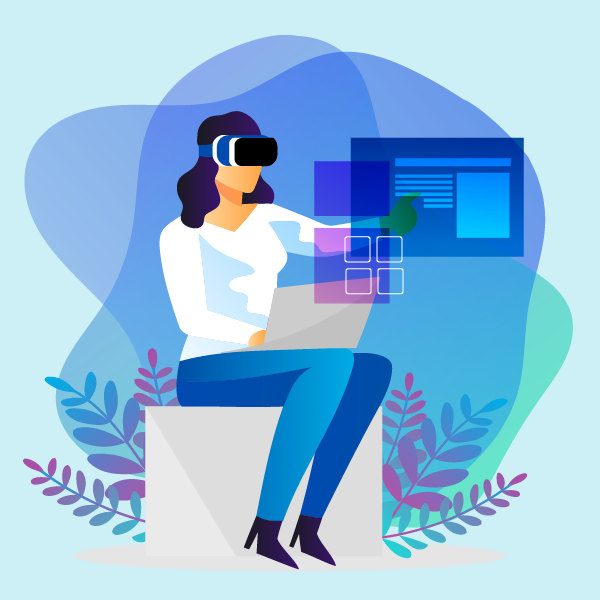
Project based virtual reality
In projector-based virtual reality, modeling of the real environment plays a vital role in various virtual reality applications, such as robot navigation, construction modeling, and airplane simulation. Image-based virtual reality systems have been gaining popularity in computer graphics and computer vision communities. In generating realistic models, it is essential to accurately register acquired 3D data; usually, a camera is used for modeling small objects at a short distance.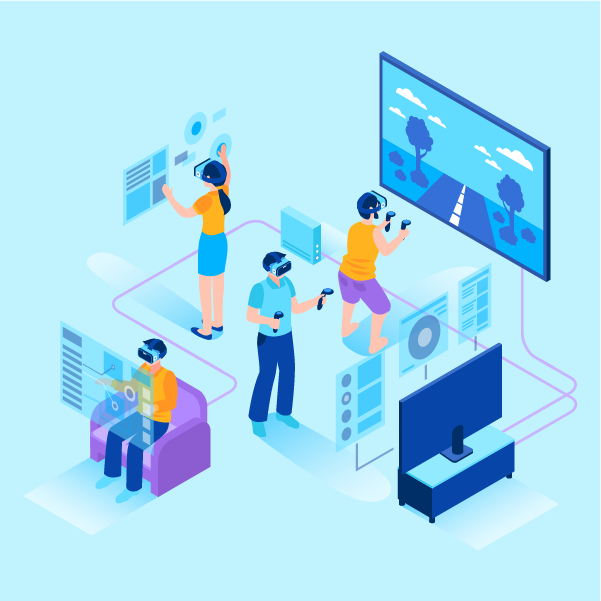
Desktop based virtual reality
Desktop-based virtual reality involves displaying a 3D virtual world on a regular desktop display without use of any specialized positional tracking equipment. Many modern first-person video games can be used as an example, using various triggers, responsive characters, and other such interactive devices to make the user feel as though they are in a virtual world. A common criticism of this form of immersion is that there is no sense of peripheral vision, limiting the user's ability to know what is happening around them.Here are 10 Amazing Uses Of Virtual Reality Today.
-
Recruitment & Training
The corporate sector has largely benefited from the revolutionary technology. Some companies are now recruiting and training their workforce by using virtual reality that engages the employees in seemingly real work challenges and scenarios. For example, during recruitment, a company can make use of simulated interviews and choose the best candidates for the job. The use of VR in the workplace can allow potential employees to have a feel of the typical work environment and be prepared to offer the best solutions for challenges that may arise. A company can also train employees from different physical locations at the same time. This also gives employees a seemingly physical involvement which offers the satisfaction gained from a real training. -
Work Collaboration in the Workplace
Some companies have embraced virtual sharing to allow personnel to collaborate on assignments without relocating to one physical location. For example, where a company has remote workers from different geographical locations, it is necessary that they coordinate and complete tasks on time. Since teamwork is essential for a company’s success, VR technology makes it possible for workers to hold meetings through video conferencing and deliberate on issues. With this technology, employees can gather in the same room and consult without meeting face to face. This saves unnecessary travel and allows them to work on assignments concurrently and complete tasks within the shortest time possible. -
Creating Ideas and Forecasting Trends
Virtual reality allows businesses to come up with fresh ideas and perform tests before implementing them in the actual environment. This immersive technology allows companies to forecast trends and determine the performance of projects beforehand. -
Pain Management
Uses of virtual reality in medicine are widespread. For example, this technology has been used in pain management for patients undergoing treatments that inflict insurmountable pain such as cancer. Each treatment pain of the cancer patient can be helped and managed. Consider other high pain treatments such as, high degree burns, physiotherapy treatments, broken limbs, and open wounds. When patients wear VR headsets, the technology is used to distract their brain and confuse the pain pathway by drawing their minds from the suffering. Dentists are also using the technology to soothe patients when extracting their teeth or conducting root canals and other dental surgeries. -
Training Medical Students
The virtual reality technology is used to assist medical students to learn and acquire work experience faster. With this use of virtual reality in education, medical students can learn how to conduct delicate surgical procedures. Since the procedures can be time-consuming and risky, VR helps the students to perform real surgeries without putting the lives of patients in danger. The trainees can also use this technology to increase their hours of practice in a virtual setting, eliminating the fear of risk on real patients. -
Treatment of PTSD
Post-traumatic stress disorder is common among soldiers due to the trauma they were exposed to during combat. This disorder has become more widespread than previously thought. PTSD is also found in the general population and is not limited to the combat soldier. PTSD is a mental disorder that faces anyone who has undergone petrifying experiences, both physically and mentally, such as sexual assault, abuse, and road accidents. Virtual reality can assist in treating the fears in patients with PTSD by helping them to replay what they went through. As a result, reliving the experiences can help the medical team to understand the patients’ conditions and come up with ways to help them cope better. -
Training on Social Cognition to Manage Autism
The number of patients suffering from autism, a social developmental disorder, has been on the rise. This problem has mainly been attributed to the increased awareness about the condition among parents and guardians – but may have many other causal conditions, including environment. Autism impairs the reasoning, interaction, and social skills of patients. Virtual reality technology can help in managing the condition by boosting the patients’ brain activity and imaging. This can be achieved through introducing the patients and parents to different social scenarios and then using medical and psychological training teaching both guardian and patient about the best usage behavior in each situation. This gives each the opportunity to practice before the occasion arises. -
Managing and Treating Anxiety Disorder
Anxiety creates a sense of panic in patients. Some describe their feelings as the individual feeling as if they have lost the ground beneath their feet. Some have chest pain or feel like they must escape to a safer location. A notable symptom of anxiety is breathing difficulties. This symptom and many other variables that the patient deals with can be monitored, explained and controlled using virtual reality. The medical team can use functional apps fused with the VR technology to monitor the individual patient’s breathing patterns and offer appropriate scenarios for the patient to consider and choose. If needed the medical team can quickly administer anxiety medication thus saving the time lapse between traditional medicinal responses. -
Therapy for Paraplegics
Persons and patients with differing physical abilities can have the opportunities to use VR tools to experience the thrills of various environments without being confined to their physical locations. Notably, VR headsets are being used to enable paraplegics to build back their brain functions and regain control of limbs. This is one of the most exciting uses of this new VR technology and can’t be overemphasized for those in this suffering state. -
Leisure
The tours and travels industry has largely benefited from the virtual reality technology. For example, the industry has been using this technology to give clients a feel of various holiday destinations around the world. Clients can visit different destinations in a virtual setting before making travel choices. In this way, the world becomes a place where all who wish to can learn and immerse themselves in other cultures and traditions. This can lead entire generations to a greater understanding and appreciation for people globally. If someone doesn’t have access to what it take to reach a destination physically, they can still visit these locales and experience the greatness offered in these regions of the world.
Summary
Virtual reality is the creation of a virtual environment presented to our senses in such a way that we experience it as if we were really there. It uses a host of technologies to achieve this goal and is a technically complex feat that has to account for our perception and cognition. It has both entertainment and serious uses. The technology is becoming cheaper and more widespread. We can expect to see many more innovative uses for the technology in the future and perhaps a fundamental way in which we communicate and work thanks to the possibilities of virtual reality.Note
If you are planning to have your own mobile application, website, custom web app or have any type of query or concern regarding its concept, technical know-how, the best way to get it done then don’t hesitate to contact us at alex@igexsolutions.com and we will provide you a free of consultation.
Skype: alex_39799
Telegram : igexsolutions
WhatsApp : +91-635-393-7367
Web Portfolio
Mobile Portfolio
Categories
What good is an idea if it remains an idea? Let's put efforts together to give it a look of Website or Mobile Application.
Let’s Start a discussion

